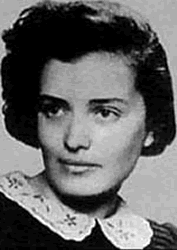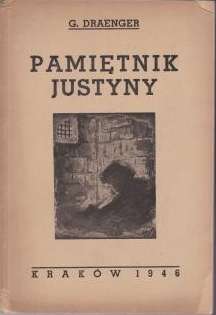Gusta Dawidson Draenger
Gusta Dawidson Draenger, code name Justyna, (1917–1943) was a Polish Jewish activist in Krakow in the late 1930s and during the Nazi occupation in World War II. She wrote a detailed account of her activities while in Montelupich Prison in early 1943. She and her husband Shimshon Draenger were executed by the Nazis in November 1943. Her memoirs were published first in Poland as Pamiętnik Justyny in 1946, then in Hebrew as יומנה של יוסטינה or Jōmānā šel Jusṭina (Justina's Diary) in 1974 and in English as Justyna's Narrative in 1996.[1][2]

Biography
Born in Krakow, Gusta Dawidson was brought up in an orthodox Jewish family of the Gur hasidim tradition. While at school, she became a member of the Agudat Yisrael youth movement. She later joined the Akiva youth movement where she actively contributed to education, becoming a member of the central committee.[1]
After German invasion of Poland in September 1939, she was one of the founders of He-Haluz Ha-Lohem ("The Fighting Pioneer"), an underground combat group in Krakow's resistance movement. She befriended Shimshon Draenger, an Akiba leader who was the editor of its journal Divrei Akiva and the weekly Tse'irim.[3]
In September 1939, the Gestapo arrested Shimshon Draenger for including an article by the anti-Nazi Austrian Irene Harand in his Divrei Akiva and for founding the Jewish Defence Movement. He was sent to the Troppau concentration camp near Opava. Now engaged to him, Gusta Dawidson gave herself up to the Germans and asked to be allowed to join him. In early 1940, thanks to a huge bribe, the two were released but had to report regularly to the Gestapo. They nevertheless continued to meet secretly with the members of their movement and soon married.[1]

Following the attack on Cyganeria Café which was frequented by German officers, Shimshon Draenger was arrested on 18 January 1943. When the Gestapo discovered Gusta Dawidson was married to him, they also arrested her. They were both sent to Montelupich Prison. While there, between frequent sessions during which she was tortured, she wrote her memoirs on toilet paper and hid them in a doorpost.[2][1]
On 29 April 1943, the couple escaped with several other prisoners and eventually joined each other in Bochnia. They proceeded to a bunker in the Nowy Wiśnicz forest from where they continued to fight. Shimshon wrote and edited the resistance newspaper He-Haluz Ha-Lohem, 250 copies of which were distributed every Friday to the ghettos and surviving Jews. While trying to help a Hungarian Jew to cross the Hungarian border, they were arrested by the Germans and executed on 8 November 1943.[2][1]
As for Gusta Dawidson's memoirs, 15 of the 20 chapters were successfully smuggled out of the prison by Draenger. After publication of the Polish and Hebrew versions in 1946 and 1974, the English Justyna's Narrative appeared in 1996.[1][4]
References
- Peled, Yael Margolin (March 2009). "Gusta Dawidson Draenger". Jewish Women's Archive. Retrieved 9 January 2018.
- "Gusta Davidson Draenger, also known by her underground name, Justyna". Eilat Gordin Levitan: Krakow Stories. Retrieved 9 January 2018.
- Elshtain, Jean Bethke (2005). Women and War: With a New Epilogue. ABC-CLIO. pp. 146–. ISBN 978-1-85109-770-8.
- Justyna (1996). Justyna's Narrative. Univ of Massachusetts Press. ISBN 1-55849-038-8.